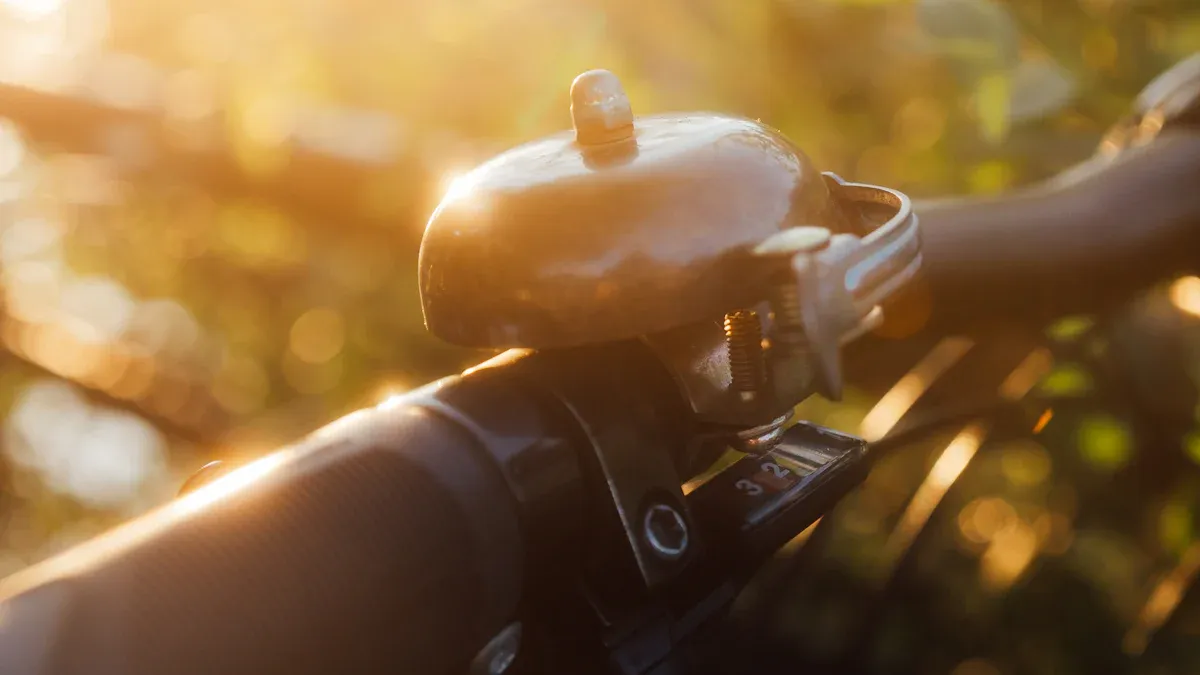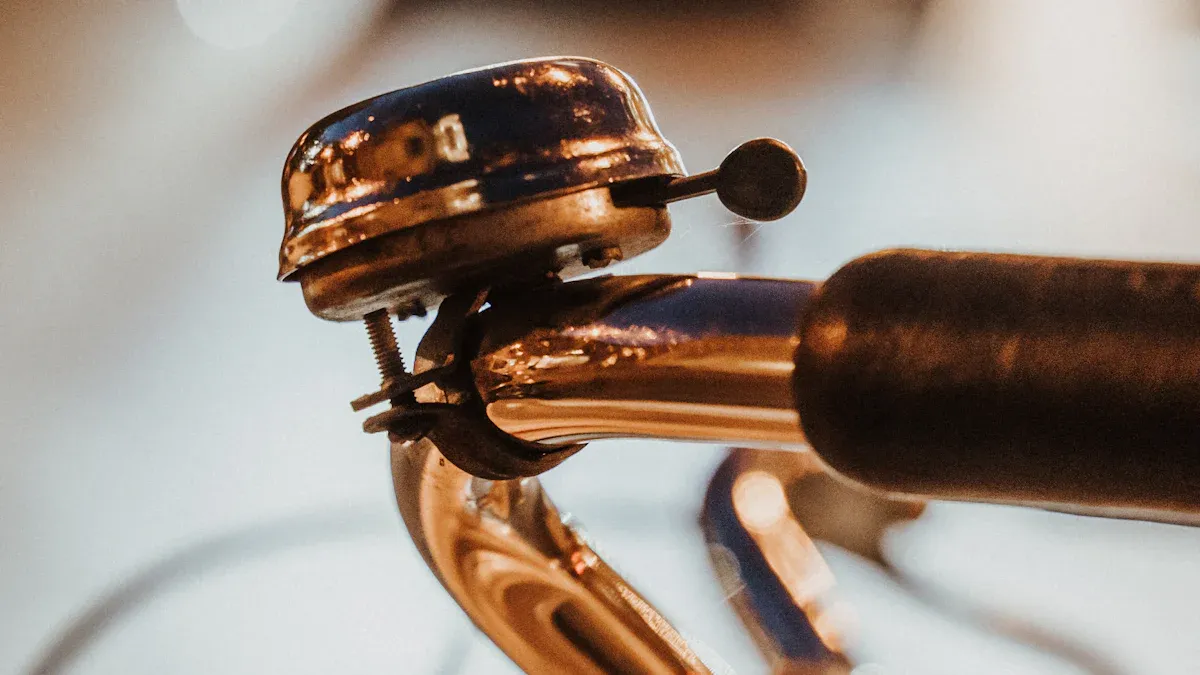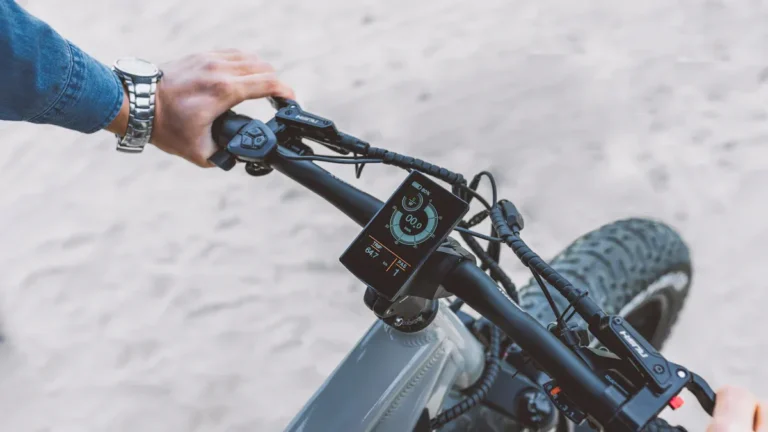
Which Bicycle Bell Is Best for You Classic, Digital, or Horn
Compare classic, digital, and horn bicycle bells to find the best fit for your ride. See which Bicycle Bells suit your style, safety, and local laws.

Choosing the best bike bells depends on your riding style. Classic bicycle bells work well for most riders who want a clear sound and simple use. Digital options suit tech fans who like extra features. Horns help you stand out in noisy places. Always check local rules about bicycle bells. Think about your safety, the sound you prefer, and what fits your bike and personality.
Key Takeaways
Classic bells offer a clear, familiar sound and fit most bike handlebars easily.
Digital bells provide multiple sound options and extra features like app control but need batteries or charging.
Horns produce very loud sounds that work well in noisy city traffic but may be restricted by local laws.
Choose a bell that matches your riding style, safety needs, and local regulations.
Easy installation and regular maintenance help keep your bell working well for years.
Kids benefit most from simple, easy-to-use classic bells with fun designs.
Test your bell’s sound in real conditions before buying to ensure it meets your needs.
Buy from trusted brands and consider whether you want to shop online or in a local store for personal help.
Bicycle Bell Types
When you choose bicycle bells, you will find three main types: classic, digital, and horn. Each type offers unique features, sounds, and mounting options. Understanding these differences helps you pick the right bell for your needs.
Classic Bells
Mechanical Sound
Classic bells use a simple mechanical system. You press or flick a lever, and the bell produces a clear “ring-ring” sound. This sound stands out in most environments and signals your presence to others. Riders have trusted stainless steel bells for over a decade, even in tough places like humid or salty coastal areas. Pewter bells develop a natural patina after a few years, which many riders see as a sign of tradition and ongoing protection. The tradition of gifting bells as protective talismans remains strong. Riders often choose bells with popular motifs such as skulls, guardian angels, or military themes. These designs show the cultural value and popularity of classic bells in many communities.
Riders appreciate the reliability of classic bells.
Many people use them as meaningful gifts or event swag.
The sound is familiar and widely recognized.
Compatibility
Classic bells fit most handlebars and offer flexible mounting options. You can attach them to different bike types, including road, mountain, and commuter bikes. Most classic bells use a simple clamp or screw system, so you do not need special tools. Their classic styling matches many bikes, making them a favorite for riders who want both function and tradition.
Digital Bells
Sound Options
Digital bicycle bells use electronic systems to create sound. You can choose from multiple tones, such as beeps, chimes, or even custom sounds. For example, the Wahoo Elemnt Ace features a built-in speaker that lets you activate the bell by double-tapping the screen. This system supports several sound options and plans to add shifter button pairing for easier access. Software updates can improve these features, giving you more control over your bell’s sound.
Extra Features
Digital bells often include extra features like Bluetooth connectivity, app integration, or programmable sounds. Some models let you adjust the volume or change the tone through your phone. These bells may also offer visual alerts or connect with other smart devices. You get more customization and flexibility, but you may need to recharge or replace batteries.
Horns
Volume
Horns stand out for their loud volume. They use air or electricity to produce a powerful sound that grabs attention. Train horns for vehicles, for example, are designed to be loud and noticeable. This high volume helps you stay safe in busy urban environments where traffic noise can drown out softer sounds.
Horns make your presence known in noisy areas.
Their loudness often leads to legal regulations in some cities.
Tone
The tone of a horn is sharp and attention-grabbing. Different brands offer unique tones, but all aim to alert others quickly. Car train horns mimic the sound of real trains, making them hard to ignore. Horns work best when you need to assert your presence on crowded streets or in heavy traffic.
Tip: Always check local laws before installing a horn, as some places limit their use due to their high volume.
Comparing Bike Bells
Sound
Volume
When you choose bike bells, volume matters a lot. Classic bells give you a clear “ring-ring” that most people recognize. These bells work well in parks or quiet streets. Digital bells let you adjust the volume. You can pick a soft beep or a louder chime. Horns stand out as the best for volume. They blast a sharp sound that cuts through city noise and busy intersections. If you ride in loud places, horns help you stay safe by making sure drivers and pedestrians hear you.
Tip: Always do a sound test before you buy. Try the bell in a noisy area to see if it meets your needs.
Type | Volume Level | Best For Volume? |
|---|---|---|
Classic | Moderate | Sometimes |
Digital | Adjustable | Sometimes |
Horn | Very Loud | Yes |
Tone Variety
Tone variety helps you pick the best sound for your ride. Classic bells offer a single, familiar tone. This makes them easy to recognize, but you cannot change the sound. Digital bells give you the best sound options. You can switch between beeps, chimes, or even custom tones. Some digital models let you upload your own sounds. Horns usually have one loud tone, but some brands offer different pitches. If you want the best sound for different situations, digital bells give you the most choices.
Ease of Use
Activation
Activation means how you make the bell ring. Classic bike bells use a lever or thumb press. You flick it, and the bell rings right away. Digital bells often use a button. Some models let you tap your handlebars or use a remote. Horns use a button or a squeeze bulb. You get instant sound with all three, but digital bells can sometimes lag if the battery is low.
Accessibility
Accessibility matters if you ride in traffic or have limited hand strength. Classic bells sit close to your grip, so you can use them without moving your hand much. Digital bells can mount anywhere, and some let you use your phone or a wireless button. Horns are bigger, so you may need to stretch your thumb or finger to reach the button. If you want the best for tool-free mounting and easy reach, look for models with flexible mounts and large buttons.
Installation
Handlebar Fit
Handlebar fit affects how well the bell stays in place. Classic bike bells fit most handlebars. They use a simple clamp that works on road, mountain, or commuter bikes. Digital bells come in different sizes. Some fit only certain handlebars, so check the specs before you buy. Horns are larger and may need more space. If you want the best for size, measure your handlebars first and pick a bell that matches.
Tools Needed
Some bike bells need tools for installation, while others do not. Classic bells often use a small screwdriver. Digital bells may use screws or a quick-release strap. Horns sometimes need a wrench or extra brackets. If you want the best for tool-free mounting, choose bells with rubber straps or snap-on clamps. These let you install or remove the bell in seconds, which helps if you switch bikes often.
Note: Always read the instructions before you start. A good fit keeps your bell secure and working well.
Durability
Weather Resistance
You want your bike bells to last through all kinds of weather. Classic bells often use stainless steel or brass. These metals resist rust and handle rain well. Some classic bells even develop a patina, which adds character without harming function. Digital bells usually have plastic or aluminum bodies. Many digital models come with water-resistant seals, but you should always check the product details. Horns can be more sensitive to water. Electric horns may stop working if water gets inside. Air horns handle rain better, but you need to dry them after heavy storms.
Tip: If you ride in wet or coastal areas, pick bike bells with a high weather resistance rating.
Maintenance
Classic bells need very little care. You might wipe them clean or add a drop of oil to the moving parts. Digital bells require battery checks and occasional cleaning of the buttons. If your digital bell uses an app, keep the software updated. Horns need more attention. Electric horns need battery changes and wire checks. Air horns need you to refill the air canister. Regular maintenance keeps your bell loud and reliable.
Style
Design
Bike bells come in many designs. Classic bells offer a timeless look. You can find them in chrome, brass, or even with engraved patterns. Many riders choose classic bells as the best looking option for vintage or commuter bikes. Digital bells look modern. They often have sleek shapes and LED lights. Horns look bold and sometimes bulky. If you want the best looking bell, match the design to your bike’s style.
Type | Design Appeal | Best Looking? |
|---|---|---|
Classic | Vintage, Elegant | Yes (for many bikes) |
Digital | Modern, Minimalist | Yes (for tech fans) |
Horn | Bold, Functional | Sometimes |
Customization
You can personalize your bike bells in many ways. Classic bells let you add stickers or choose from engraved designs. Some brands offer custom motifs, which makes them the best for minimalism if you want a simple, clean look. Digital bells allow you to change sounds or light colors. This gives you more ways to match your bell to your personality. Horns offer fewer customization options, but you can sometimes pick the color or tone. If you want the best for minimalism, look for bells with simple shapes and no extra decorations.
Legal
Local Rules
You must know the local rules before you pick a bell. Many cities and states require bike bells for safety. Some places ban loud horns or digital bells with siren sounds. Classic bells almost always meet legal standards. Digital bells and horns may not. Always check your city’s bike laws before you buy.
Compliance
To stay compliant, choose bike bells that meet your area’s sound and volume limits. Classic bells usually pass these tests. Digital bells with adjustable volume help you follow the rules. Horns can be too loud for some places. If you want to avoid fines, read the product specs and local laws. Pick a bell that keeps you safe and legal.
Pros and Cons
Classic
Classic bicycle bells give you a simple and reliable way to alert others. You get a clear sound that most people recognize right away. These bells often last for years with little maintenance. You can find many designs, so you can match your bell to your bike’s style. Classic bells usually fit most handlebars, which makes them easy to install.
Pros:
Easy to use with a quick flick or press.
Durable materials like brass or stainless steel resist rust.
Fits most bikes and handlebar sizes.
Offers a familiar sound that meets most legal requirements.
Many styles and motifs available.
Cons:
Only one tone, so you cannot change the sound.
Not as loud as horns in busy city traffic.
Fewer extra features compared to digital bells.
If you want the best value for everyday riding and simple safety, classic bells often meet your needs.
Digital
Digital bells bring technology to your handlebars. You can choose from different sounds and even adjust the volume. Some models let you connect to your phone or other devices. You may also get extra features like lights or app controls. Digital bells look modern and can match high-tech bikes.
Pros:
Multiple sound options for different situations.
Adjustable volume helps you stay within legal limits.
Some models offer Bluetooth or app integration.
Sleek, modern designs.
Cons:
Needs batteries or charging, which adds maintenance.
May lag if the battery runs low.
Not always as weather-resistant as classic bells.
Some models cost more than basic bells.
Digital bells give you flexibility, but you must check if they offer the best value for your budget and riding style.
Horns
Horns stand out for their loud, attention-grabbing sound. You can use them in noisy environments where a regular bell might not work. Horns come in different types, such as air or electric. Some let you pick the tone, but most focus on volume.
Pros:
Very loud, so people hear you in busy areas.
Good for city riding or crowded streets.
Some models let you choose the tone.
Cons:
May not be legal in all places due to high volume.
Bulky design can take up more space on your handlebars.
Electric horns need batteries or charging.
Not as stylish or customizable as classic bells.
Always check your local laws before using a horn. You want to stay safe and avoid fines.
Type | Pros | Cons |
|---|---|---|
Classic | Reliable, easy, legal, stylish | One tone, less loud, fewer features |
Digital | Custom sounds, tech features, modern | Needs power, can lag, higher cost |
Horns | Loud, best for noisy areas | Legal limits, bulky, needs power |
Choosing Bike Bells
For Commuters
You ride your bike to work or school almost every day. You need a bell that works in many situations. Classic bells give you a clear sound that most people recognize. You can trust them to last through rain and sun. Most classic bells fit any handlebar, so you do not need to worry about compatibility.
Digital bells also work well for commuters who like extra features. Some digital models let you change the sound or adjust the volume. You can pick a soft chime for quiet streets or a louder beep for busy roads. Many digital bells have modern designs that look good on city bikes.
Tip: Choose a bell that you can reach easily without moving your hand too far from the grip. This helps you stay safe in traffic.
Best Choices for Commuters:
Classic bells for reliability and legal compliance.
Digital bells for adjustable sound and modern style.
For Urban Riders
City streets can get loud and crowded. You need a bell that cuts through the noise. Horns stand out in busy urban areas. They produce a loud, sharp sound that drivers and pedestrians notice right away. Some horns let you pick the tone, but most focus on volume.
Classic bells still work in cities, especially in bike lanes or parks. Their familiar “ring-ring” sound tells people you are coming. Digital bells give you more options. You can switch between sounds or increase the volume when needed.
Bell Type | Urban Advantage | Drawback |
|---|---|---|
Classic | Recognizable sound | May be too quiet |
Digital | Adjustable volume | Needs batteries |
Horn | Very loud, attention | May not be legal |
Note: Always check your city’s rules. Some places do not allow very loud horns.
For Kids
Kids need bells that are easy to use and fun. Classic bells work best for most children. They use a simple lever or thumb press. The sound is not too loud, so it will not scare other kids or pets. Many classic bells come in bright colors or with fun designs like animals or superheroes.
Digital bells can also be a good choice for older kids who like gadgets. Some digital models let kids pick different sounds. Make sure the bell is not too complicated for your child to use.
Look for bells with large buttons or levers.
Pick a design your child likes. This makes them more likely to use the bell.
Avoid horns for young kids. They can be too loud and hard to control.
Safety Tip: Teach your child to use the bell before every turn or when passing others. This builds good habits and keeps everyone safe.
For Off-Road
When you ride off-road, your bike faces rough trails, mud, and unpredictable weather. You need a bell that can handle these challenges. Classic bells often work best for off-road riding. They use strong materials like brass or stainless steel. These metals resist rust and damage from dirt or water. You can trust a classic bell to keep working after many rides in the woods or on mountain trails.
Digital bells can also serve you well if you want more features. Some digital models come with waterproof ratings and tough cases. You can choose different sounds, which helps when you ride in areas with hikers or other cyclists. However, you must check the battery before each ride. A dead battery means no sound, which can be risky on remote trails.
Horns rarely suit off-road use. They often have bulky designs and need extra space on your handlebars. You may find them hard to mount on mountain bikes with narrow bars or extra gear. Horns also use batteries or air canisters, which add weight and need regular checks. Most off-road riders skip horns unless they ride in very crowded parks.
Tip: Pick a bell with a loud, clear sound. Mud and trees can muffle weak bells. Test your bell before you hit the trail.
Key Features for Off-Road Bells
Durability: Choose bells made from metal or high-quality plastic.
Weather Resistance: Look for water-resistant or waterproof models.
Easy Activation: Make sure you can ring the bell with gloves on.
Secure Mounting: Use a clamp or strap that holds tight over bumps.
Bell Type | Off-Road Advantage | Drawback |
|---|---|---|
Classic | Durable, simple, reliable | One tone, less tech features |
Digital | Custom sounds, waterproof | Needs battery, may cost more |
Horn | Very loud (rarely needed) | Bulky, heavy, not trail-ready |
You want a bell that stays in place and works every time. Classic bells give you peace of mind. Digital bells offer more options if you like tech. Always check your bell after each ride. Clean off mud and check for damage. This keeps your bell ready for your next adventure.
Note: Some parks require bells for safety. Always follow local rules and respect other trail users.
Installation Tips

Step-by-Step
Installing a bicycle bell is a simple process if you follow the right steps. Start by choosing the best spot on your handlebar. Most riders mount the bell on the left side at the lowest point of the frame. This position helps you reach the bell quickly and keeps it out of the way. Make sure the bell does not block any controls or cables.
Place the bell on the handlebar and check that it can swing freely.
Use the provided clamp, hanger, or a sturdy zip tie to secure the bell. Tighten it so the bell does not move when you ride.
Avoid placing the bell near heat sources like exhaust pipes. Heat can damage the bell and shorten its life.
Check that the bell does not catch on debris or interfere with moving parts.
Test the bell to make sure it rings clearly.
Tip: If you have a crowded handlebar, look for a bell that is best for size. Smaller bells fit better and leave room for other gear.
Maintenance
Regular maintenance keeps your bell working well for years. The care you give depends on the bell’s material.
Pewter bells need occasional polishing. This keeps them shiny and helps maintain their softer sound.
316L stainless steel bells require almost no maintenance. They resist tarnishing and work well in harsh weather.
Black powder coat finish bells offer extra protection from rust. Wipe them clean with a soft cloth.
Gold-tone bells need gentle cleaning to keep their color bright.
Always check that the bell is tightly attached. If you ride in wet or muddy areas, clean the bell after each ride. Avoid using harsh chemicals. A little care goes a long way.
Note: Proper placement and material choice help your bell last longer and perform better.
Troubleshooting
Sometimes a bell stops working as it should. You can fix most problems with a few simple checks.
Problem | Solution |
|---|---|
Bell does not ring | Check if debris blocks the striker. Clean it. |
Bell is loose | Tighten the clamp or zip tie. |
Sound is weak | Make sure the bell swings freely. |
Bell tarnishes | Polish or clean based on the material. |
Digital bell won’t work | Replace or recharge the battery. |
If your bell still does not work, check the mounting position. Move the bell if it hits other parts or gets in the way. For digital bells, update the software if possible. Always follow the user manual for your specific model.
Tip: Test your bell before every ride. A working bell keeps you safe and helps others notice you.
User Experiences
Cyclist Feedback
You can learn a lot from other cyclists who use different types of bike bells. Many riders share their stories online or in local bike groups. Their feedback helps you see what works best in real life.
Classic Bells:
Riders often say classic bells feel reliable. You get a clear sound that people recognize. Many commuters mention that classic bells last for years, even with daily use. Some cyclists like the traditional look and enjoy picking a bell that matches their bike’s style. Parents often choose classic bells for their kids because they are easy to use and not too loud.Digital Bells:
Tech-savvy cyclists enjoy digital bells. You can change the sound or adjust the volume. Some riders like using their phone to control the bell. Others mention that digital bells stand out on modern bikes. However, you may need to remember to charge the battery. A few users say digital bells can stop working in heavy rain if they are not water-resistant.Horns:
Urban riders who face heavy traffic often pick horns. You get a loud sound that cuts through city noise. Some cyclists say horns help them feel safer in busy areas. Others warn that horns can annoy pedestrians or break local noise rules. You should always check your city’s laws before using a horn.
Tip: Try asking other cyclists about their bells before you buy. Real stories can help you avoid common problems.
Here is a quick summary of what cyclists say:
Bell Type | What Riders Like | What Riders Dislike |
|---|---|---|
Classic | Reliable, easy, stylish | One sound, not loud in traffic |
Digital | Custom sounds, tech features | Needs charging, can break |
Horn | Very loud, good for city traffic | Bulky, may be illegal |
Expert Insights
Bike experts and safety instructors often test many types of bells. They look for features that keep you safe and make riding easier.
Experts recommend classic bells for most riders. You get a sound that people expect. Classic bells usually meet legal rules in most places. You can install them quickly and trust them in all weather.
Digital bells impress experts who focus on technology. You can program different sounds for different situations. Some experts say digital bells work well for riders who want more control. However, experts warn that you must check the battery often.
Horns get mixed reviews from experts. You get the loudest sound, which helps in noisy cities. However, experts remind you that some horns break noise laws. You should use horns only where they are allowed.
Note: Experts say you should always test your bell before riding in a new area. Make sure people can hear you and that your bell follows local rules.
You can use both cyclist feedback and expert advice to choose the best bell for your needs. Listen to real stories and check expert tips. This way, you make a smart and safe choice for your bike.
Where to Buy
Brands
You can find many brands that make high-quality bicycle bells. Each brand offers different features, styles, and price points. Some brands focus on classic designs, while others lead in digital or horn technology. Here are some popular brands you might want to check out:
Knog: Known for modern, stylish bells. Many riders like Knog for its unique designs and clear sound.
Crane: Offers classic Japanese bells. You get a strong, long-lasting ring with Crane bells.
Spurcycle: Makes premium bells in the USA. Spurcycle bells stand out for their loud, crisp sound and durable build.
Mirrycle: Popular for affordable and reliable bells. Mirrycle bells fit most handlebars and work well for daily use.
Hornit: Specializes in loud electronic horns. Hornit products help you stay safe in busy cities.
Oi: Delivers minimalist bells with a sleek look. Oi bells blend in with your handlebars and suit modern bikes.
Tip: Always check the brand’s warranty and customer reviews before you buy. A good warranty gives you peace of mind.
Here is a quick comparison of some top brands:
Brand | Type | Key Feature | Price Range |
|---|---|---|---|
Knog | Classic/Digital | Modern design | $ |
Crane | Classic | Long-lasting ring | $ |
Spurcycle | Classic | Premium build | $$ |
Mirrycle | Classic | Easy installation | $ |
Hornit | Horn/Digital | Loudest sound | $-$$ |
Oi | Classic | Minimalist style | $ |
Online vs. Store
You can buy bicycle bells both online and in local bike shops. Each option has its own benefits. Your choice depends on what matters most to you.
Buying Online:
You get a wider selection. Online stores often carry more brands and models.
You can compare prices quickly. Many websites offer customer reviews and ratings.
Shopping online saves you time. You can order from home and get the bell delivered to your door.
Some online shops offer exclusive deals or bundles.
Buying in a Store:
You can see and test the bell before you buy. This helps you check the sound and fit.
Store staff can answer your questions and help you pick the right bell.
You get your bell right away. No need to wait for shipping.
Local shops often provide installation help.
Note: If you want to support your community, buy from a local bike shop. You help small businesses and get personal service.
Here is a quick guide to help you decide:
Where to Buy | Best For | Drawback |
|---|---|---|
Online | Variety, convenience | No hands-on testing |
Store | Personal help, testing | Smaller selection |
You should think about your needs and preferences. If you want the latest models or special features, online shopping works best. If you value expert advice and want to try before you buy, visit a local store. Either way, you can find the perfect bell for your bike.
Choosing the right bicycle bell depends on your needs. Classic bells work best for most riders. Digital bells suit tech fans. Horns help in noisy cities. Use this quick checklist:
Need reliability? Pick a classic bell.
Want tech features? Try a digital bell.
Ride in heavy traffic? Choose a horn.
Stay safe and follow local rules. Which bell fits your style? Share your choice in the comments! 🚲🔔
FAQ
Are bicycle bells required by law in most places?
You should check your local bike laws. Many cities and states require a bell or audible warning device. Classic bells usually meet these rules. Horns and digital bells may not always comply.
Can you install a bell on any type of bike?
Most bells fit standard handlebars. You can install them on road, mountain, or commuter bikes. Some digital bells or horns need extra space. Always check the handlebar diameter before buying.
How do you maintain a bicycle bell?
You should clean your bell regularly. Wipe off dirt and moisture. For classic bells, add a drop of oil to moving parts. Digital bells need battery checks. Horns may need air or battery replacements.
Which bell is loudest for city riding?
Horns give you the loudest sound. They work best in heavy traffic or noisy areas. Digital bells can also reach high volumes. Classic bells sound clear but may not cut through city noise.
Do digital bells drain battery quickly?
Most digital bells use batteries efficiently. You should charge or replace batteries as needed. Using extra features like lights or Bluetooth may drain power faster. Always check battery life before long rides.
Can kids use any type of bell?
You should pick a simple bell for kids. Classic bells with a thumb lever work best. They are easy to use and not too loud. Avoid horns for young children. Digital bells suit older kids who like gadgets.
What should you do if your bell stops working?
First, check for dirt or debris. Tighten the clamp. For digital bells, replace or recharge the battery. If the bell still does not work, consult the user manual or ask a bike shop for help.


